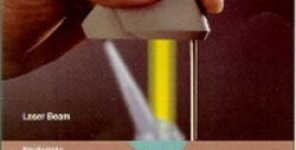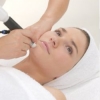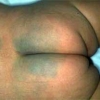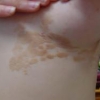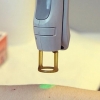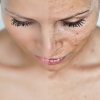Trattamento con laser ad alessandrite Q-switched delle lentiggini facciali e labiali associate alla sindrome di Peutz-Jeghers
 Il laser ad alessandrite Q-switched utilizzato a 752 nm, una lunghezza d'onda ben assorbita dalla melanina rispetto ad altre strutture otticamente assorbenti della pelle, provoca la distruzione altamente selettiva delle cellule cariche di pigmenti.
Il laser ad alessandrite Q-switched utilizzato a 752 nm, una lunghezza d'onda ben assorbita dalla melanina rispetto ad altre strutture otticamente assorbenti della pelle, provoca la distruzione altamente selettiva delle cellule cariche di pigmenti.
Inoltre, la durata dell'impulso di 75 nanosecondi prodotta da questo laser approssima il tempo di rilassamento termico per i melanosomi, convogliando in tal modo l'energia ad un solo bersaglio. Le macchie di colore marrone scuro, sul viso e sulle labbra, sono caratteristiche dei pazienti con la sindrome di Peutz-Jeghers. Queste lentiggini possono essere esteticamente deturpanti. Il laser ad alessandrite Q-switched produce la scomparsa clinicamente significativa della melanosi mucocutanea in associazione con la sindrome di Peutz-Jeghers, senza complicazioni viste spesso con altre modalità terapeutiche.
OBIETTIVI:
Valutare l'efficacia e la sicurezza del laser ad alessandrite Q-switched per il trattamento delle lentiggini facciali e labiali nella sindrome di Peutz-Jeghers.
SOGGETTI:
43 pazienti con diagnosi della sindrome di Peutz-Jeghers sono stati trattati e studiati nel nostro centro di terapia laser dal 2000 al 2010.
METODI:
Abbiamo usato un laser ad alessandrite Q-Switched specifico per la lunghezza degli impulsi a 75 ns, emessa a 752 nm e con uno spot di luce del diametro di 2.4 mm. La cute lesionata è stata irradiata con fluenze di 5-7 J/cm2. Gli intervalli di trattamento sono stati di 3 mesi.
RISULTATI:
Dopo il trattamento con il laser ad alessandrite Q-switched, il 55.8% (24/43) dei pazienti ha mostrato ottimi risultati (dove i pigmenti sono scomparsi per più del 75%), e il 44.2% (19/43) ha mostrato buoni risultati. Sono state necessarie tre sessioni per ottenere ottimi risultati. Non abbiamo osservato complicanze gravi.
CONCLUSIONI:
Il laser ad alessandrite Q-switched ha portato ad un risultato soddisfacente nel trattamento delle lentiggini e pertanto lo abbiamo considerato il migliore trattamento per queste lesioni.
Storia della pubblicazione:
Titolo: Q-switched alexandrite laser treatment of facial and labial lentigines associated with Peutz-Jeghers syndrome.
Rivista: Photodermatol Photoimmunol Photomed. 2012 Aug;28(4):196-9. doi: 10.1111/j.1600-0781.2012.00672.x.
Autori: Li Y, Tong X, Yang J, Yang L, Tao J, Tu Y.
Affiliazioni: Department of Dermatology, Affiliated Union Hospital, Tongji Medical College, Huazhong University of Science and Technology, Wuhan, China.
Abstract:
BACKGROUND:
The Q-switched alexandrite laser used at 752 nm, a wavelength well absorbed by melanin relative to other optically absorbing structures in skin, causes highly selective destruction of pigment-laden cells. In addition, the 75-nanosecond pulse duration produced by this laser approximates the thermal relaxation time for melanosomes, thereby confining the energy to the target. Facial and labial dark brown macules quickly identify patients with Peutz-Jeghers syndrome. These lentigines may be cosmetically disfiguring. The Q-switched alexandrite laser produces clinically significant fading of mucocutaneous melanosis in association with Peutz-Jeghers syndrome without complications often seen with other therapeutic modalities.
OBJECTIVES:
To evaluate the efficacy and safety of the Q-switched alexandrite laser in treating facial and labial lentigines of Peutz-Jeghers syndrome.
SUBJECTS:
43 patients diagnosed with Peutz-Jeghers syndrome were treated and studied in our laser center from 2000 to 2010.
METHODS:
We used a Q-switched alexandrite laser specified with 75 ns pulse length, emitting at 752 nm and with a 2.4 mm-diameter spot size. The lesional skin was irradiated with fluences of 5-7 J/cm2. The treatment intervals were 3 months.
RESULTS:
After treatment with the Q-switched alexandrite laser, 55.8% (24/43) of the patients had excellent results in which more than 75% of the pigments cleared, and 44.2% (19/43) showed good results. Three sessions were required to obtain excellent results. We observed no serious complications.
CONCLUSIONS:
We obtain a successful outcome in the treatment of these lentigines with Q-switched alexandrite laser and consider it the treatment of choice for these lesions.
https://www.youtube.com/@djfdm
